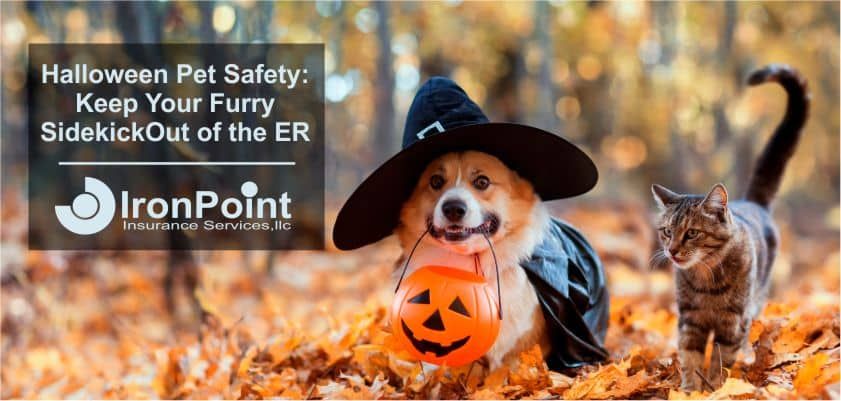Halloween Pet Safety: Keep Your Furry Sidekick Out of the ER

Halloween is all fun and games… until your dog thinks the candy bowl is an all-you-can-eat buffet or your cat decides the fake cobwebs are their new jungle gym. That’s why a little Halloween pet safety goes a long way.
What makes October 31 magical for humans—costumes, candy, chaos—can be a nightmare for pets. From toxic treats to doorbell overload, Halloween is basically a smorgasbord of hazards wrapped in orange and black packaging.
But here’s the good news: with some foresight and a touch of common sense, you can keep your furry family members safe while still enjoying the spooky season. This guide digs into the most common Halloween hazards, why they matter, and how to handle them like a pro.
Why Halloween is Hard on Pets
Imagine it from your dog’s perspective: strangers in masks appear at the door every two minutes, the doorbell never stops, and the house is filled with strange smells, loud noises, and glowing decorations. To a cat, that flickering jack-o’-lantern looks like a new toy. To a dog, the candy bowl smells like a jackpot.
What we see as harmless fun, pets experience as sensory overload. Some pets handle it with mild confusion; others spiral into full-blown panic. And panic often leads to bad decisions—running out the front door, chewing dangerous objects, or wolfing down something toxic.
If you’ve already read our Pets and Holidays guide, you know every celebration comes with its own set of pet hazards. Halloween is the perfect storm: candy, costumes, chaos, and decorations all at once.
Candy: The Number One Trick (and Not a Treat)
On Halloween night, your candy bowl isn’t just a sugar rush for kids—it’s a toxic buffet for pets. Dogs in particular are experts at sniffing out chocolate, which contains theobromine and caffeine. Both overstimulate their nervous system and heart, leading to vomiting, diarrhea, tremors, seizures, or worse.
And chocolate isn’t the only culprit. Sugar-free gum and candies often contain xylitol, which can drop a dog’s blood sugar dangerously low within minutes. Grapes and raisins—the innocent little snack boxes tossed in kids’ bags—are linked to kidney failure in dogs. Even fatty snacks can inflame the pancreas, landing you in the ER with a very sick pup.
Halloween Pet Safety tips for candy:
- Keep bowls and bags completely out of reach—high shelves, closed cabinets, locked rooms.
- Brief kids and guests before festivities: “No sharing with the pets. Ever.”
- Secure trash bins—wrappers and foil can choke or block intestines.
- If your pet gets into candy, call your vet or ASPCA Poison Control immediately.
And remember: these emergencies don’t wait until morning. Late-night vet visits are expensive, which is where pet insurance coverage saves you from financial horror stories.
Costumes: Cute or Cruel?
Yes, your corgi looks hilarious as a taco. But here’s the reality: most pets don’t care how many Instagram likes they get. Costumes can restrict breathing, vision, or movement. They can cause overheating. Small pieces can be chewed off and swallowed.
Even if a costume fits properly, some pets just plain hate wearing them. Stress shows up as pacing, panting, trying to wiggle free, or flat-out freezing in place. That’s not “adorable”—that’s discomfort.
Safer alternatives:
- Test the costume days in advance. If your pet resists, ditch it.
- Stick to festive collars, bandanas, or harnesses for style points without stress.
- If you do use a costume, supervise constantly and never leave them dressed while unattended.
Halloween should be fun for you and your pet. If the outfit makes them miserable, skip the photo-op.
Doorbell Drama: Stranger Danger on Repeat
For many pets, the doorbell is already a trigger. Now imagine it ringing every five minutes, followed by masked strangers yelling “Trick or treat!” No wonder so many pets lose it on Halloween.
The real danger isn’t just barking or pacing—it’s escape. One spooked dash through an open door can send your dog running into the night. And cats? They’re masters of slipping out unnoticed in the chaos.
How to handle the door:
- Create a safe zone away from the front door. Stock it with toys, bedding, and fresh water. Add white noise, calming music, or the TV to mask sounds.
- For highly anxious pets, ask your vet about calming aids.
- Double-check collars, ID tags, and microchips in case they bolt.
Your dog won’t remember missing the trick-or-treaters. They will remember the comfort of their safe retreat.
Decorations: Insta-Worthy, Pet-Dangerous
Halloween décor looks great on social media. To pets, it’s a minefield of hazards.
- Jack-o’-lanterns and candles: tails and fire don’t mix.
- Glow sticks: the liquid isn’t deadly but causes drooling, gagging, and vomiting.
- Fake cobwebs: they tangle easily and can choke or block intestines if swallowed.
- Electrical cords: pets chew them, risking burns or electrocution.
Pro move: do a “pet-eye-level” sweep before decorating. Anything shiny, dangling, or glowing is basically a neon sign saying “chew me.”
Walks on Halloween Night: Proceed with Caution
Taking your dog for a walk at 8 p.m. sounds innocent… until you factor in screaming kids, flashing lights, costumes, and spooky decorations. For anxious pets, it’s a nightmare.
How to adjust:
- Walk before trick-or-treating starts.
- Use reflective collars, LED leashes, or harnesses for visibility.
- Stick to short leashes—no extendables on Halloween night.
- If your dog is highly anxious, skip the walk altogether and stick to backyard breaks.
This isn’t the night to test your dog’s nerves.
Your Halloween Pet Safety Checklist
Here’s a quick recap you can stick on the fridge:
- Keep candy out of reach and secure trash bins.
- Test costumes early; skip them if your pet is uncomfortable.
- Create a safe retreat away from the door.
- Pet-proof decorations before the big night.
- Adjust walks or skip them if necessary.
- Keep your vet’s number handy and make sure your pet insurance plan is up to date.
Bookmark this or share it with friends—it’s the cheat sheet for a safer Halloween.
When Things Go Wrong
Even with the best preparation, accidents happen. Maybe your dog gets into the candy stash. Maybe your cat knocks over a candle. Maybe your guests aren’t as careful as you’d like.
That’s why it pays to plan ahead:
- Know the location of your nearest 24/7 emergency vet.
- Keep the ASPCA Poison Control number handy.
- Have a backup ride plan in case you need transportation quickly.
- Don’t hesitate—if you suspect poisoning, get help immediately.
This is where financial preparedness matters too. Emergency visits can run hundreds or thousands of dollars. Having coverage through pet insurance means you’re not stuck choosing between your pet’s health and your budget. If you’re still deciding, check out our guide: Should I Buy Pet Insurance?.
Wrapping Up: Make Halloween Safe, Not Scary
Halloween doesn’t have to be a nightmare for pets. With some planning—keeping candy secure, making costumes comfortable, creating safe zones, and pet-proofing decorations—you can celebrate without worrying about a 2 a.m. emergency vet run.
Holidays should be fun for the whole family, four-legged members included. And Halloween pet safety is just one piece of the puzzle. For more seasonal tips, explore our Pets and Holidays guide—it covers everything from Christmas tinsel to Fourth of July fireworks.
Because the scariest part of Halloween shouldn’t be your vet bill. It should be your neighbor’s questionable zombie makeup.

Quote & Pet Insurance Online Today
Start a pet insurance quote today & be prepared for the unexpected. We make it fast, safe, and secure.
- Let’s Get Started!
-
Have an Agent Call
- Compare Business Quotes
-
Business Owners’ Policy
-
Workers’ Compensation
-
General Liability
-
Commercial Auto
-
Cyber Liability
- Personal Insurance
-
Auto
-
Home / Condo / Renters
-
Motorcycle
-
Classic Car
-
Boat / Yacht
- Quote & Buy Online
-
Small Business Insurance
-
Mexico Auto Insurance
-
Pet Insurance
Call 1-877-334-7646 to speak with an insurance specialist.
Halloween Pet Safety — FAQs
Call your vet or ASPCA Poison Control immediately. Note your dog’s weight, the type of chocolate, an estimate of how much was eaten, and whether wrappers were ingested. Do not induce vomiting unless a veterinarian instructs you to.
Key Takeaways:
- Halloween pet safety starts with preparation — secure candy, set boundaries, and keep pets calm.
- Costumes, decorations, and doorbells can stress your pets; create a quiet “safe zone” to help them feel secure.
- Know your emergency vet contact info and review your pet insurance coverage before the big night.